Categories: Home automation, Energy saving
Number of views: 64528
Comments on the article: 2
Schemes of motion sensors and the principle of their work, wiring diagrams
A motion sensor is most often used to turn on lighting when you walk or are near it. With it, you can save electricity and save yourself the trouble of flipping a switch. This device is also used in alarm systems to detect unwanted intrusions. In addition, they can be found on production lines, they are needed there for the automated execution of any technological tasks. Motion sensors are sometimes called occupancy sensors.
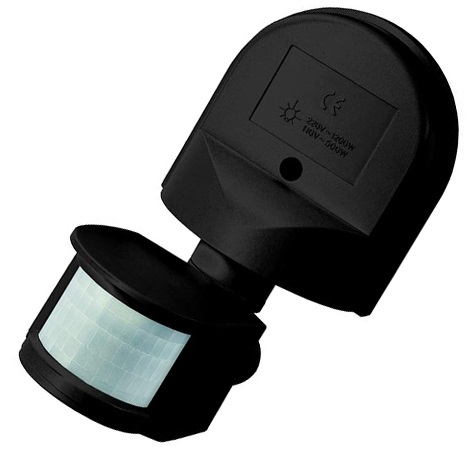
Types of motion sensors
Motion sensors distinguish according to the principle of action, their work, accuracy of operation and features of use depend on this. Each of them has strengths and weaknesses. The final price of such a sensor also depends on the design and type of element used.
The motion sensor can be made in one housing and in different buildings (the control unit is separate from the sensor).
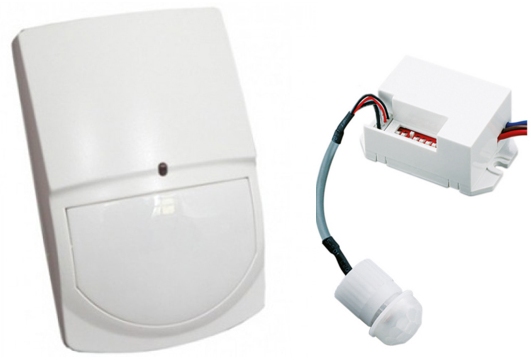
Contact
The easiest option for a motion sensor is to use limit switch or reed switch. Reed switch (sealed contact) is a switch that trips when a magnetic field appears. The essence of the work is to install a limit switch with normally open contacts or a reed switch on the door, when you open it and go into the room, the contacts will close, turn on the relay, and it will turn on the light. Such a circuit is shown below.
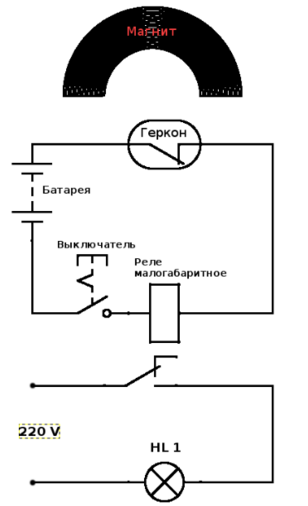
Infrared
They are triggered by thermal radiation, react to changes in temperature. When you enter the field of view of such a sensor, it is triggered by thermal radiation from your body. The disadvantage of this method of determination are false positives. Thermal radiation is inherent in everything that is around. Here are a few examples:
1. IR motion sensor It stands in a room with an electric heater, which is periodically turned on and off by timer or thermostat. When the heater is turned on, false alarms are possible. You can try to avoid this with a long and rigorous adjustment of sensitivity, as well as an attempt to direct it so that there is no heater in direct line of sight.
2. When installing on the street, triggering from gusts of warm wind is possible.
In general, these sensors work fine, and this is the cheapest option. A PIR sensor is used as a sensitive element; it creates an electric field proportional to thermal radiation.
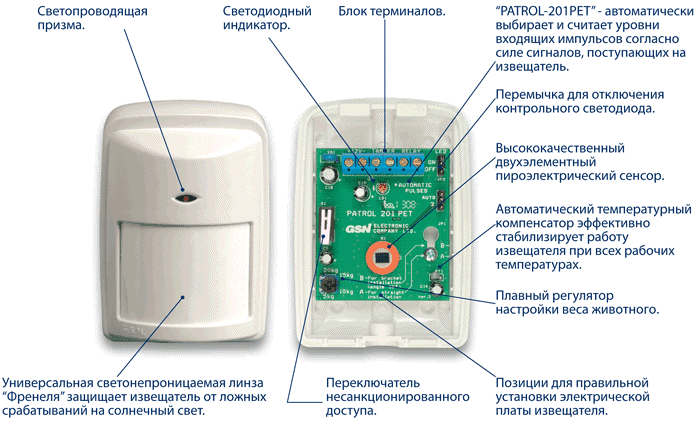
But the sensor itself does not have a wide orientation, a Fresnel lens is installed on top of it.

It will be more correct to say - multi-segment lens, or multi-lens. Pay attention to the window of such a sensor, it is divided into sections, these are the segments of the lenses, they focus the incident radiation into a narrow beam and direct it to the sensitive area of the sensor. As a result of this, radiation beams from different sides fall on the small receiving window of the pyroelectric sensor.
To increase the efficiency of motion detection, dual or quadruple sensors or several separate ones can be installed. Thus, the field of vision of the device expands.
Based on the foregoing, it should be noted that the sensor should not receive light from the lamp, and there should not be incandescent lamps in its field of view, it is also a strong source of infrared radiation, then the operation of the system as a whole will be unstable and unforeseen. Infrared radiation does not pass well through the glass, so it will not work if you go outside a window or a glass door.
This is the most common type of sensor, you can buy it or you can assemble it yourself on the basis of, so let's consider its design in detail.
How to assemble an IR motion sensor with your own hands?
The most common option is the HC-SR501. It can be bought at the radio parts store, on the ali-express, often supplied in Arduino kits. It can be used both in conjunction with a microcontroller, or independently. It is a printed circuit board with a microcircuit, strapping and one PIR sensor. The latter is covered with a lens, there are two potentiometers on the board, one of them regulates the sensitivity, and the second time a signal is present at the output of the sensor. When detecting movement at the output, a signal appears and the set time is held.
It is powered by a voltage of 5 to 20 volts, operates at a distance of 3 to 7 meters, and the output signal holds from 5 to 300 seconds, you can extend this period if you use one-shot on NE555microcontroller or time delay relay. The viewing angle is about 120 degrees.
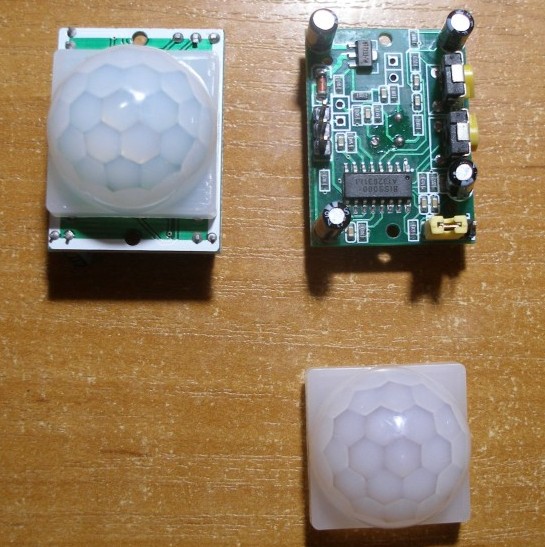
The photo shows the sensor assembly (left), the lens (bottom right), the reverse side of the board (top right).
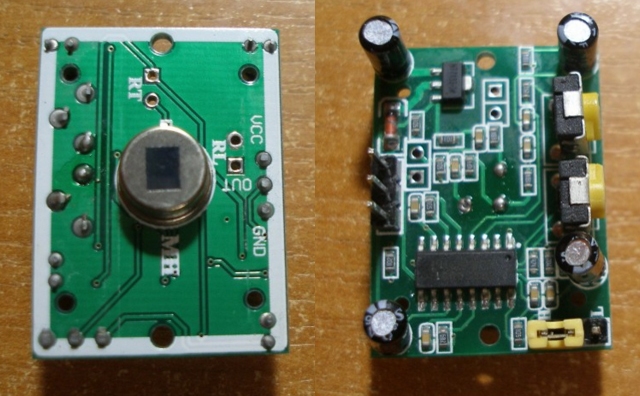
Consider the board in more detail. On its front side is a sensing element. On the back there is a microcircuit, its harness, on the right there are two tuning resistors, where the upper one is the signal delay time and the lower one is the sensitivity. In the lower right part of the jumper to switch modes H and L. In mode L, the sensor gives an output signal only it is the period of time set by the potentiometer. Mode H gives a signal while you are in the sensor coverage area, and when you leave the signal, it will disappear after the time set by the upper potentiometer.
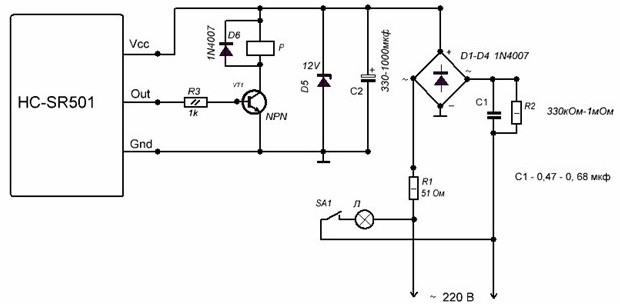
If you want to use the sensor without microcontrollers, then assemble this circuit, all the elements are signed. The circuit is fed through a quenching capacitor, the supply voltage is limited to 12V using a zener diode. When a positive signal of relay P appears at the output of the sensor, it is turned on through an NPN transistor (for example, BC547, mje13001-9, KT815, KT817 and others). You can use a car relay or any other with a 12V coil.
If you need to implement some other functions - you can use it in tandem with a microcontroller, for example Arduino board. Below is the connection diagram and program code.

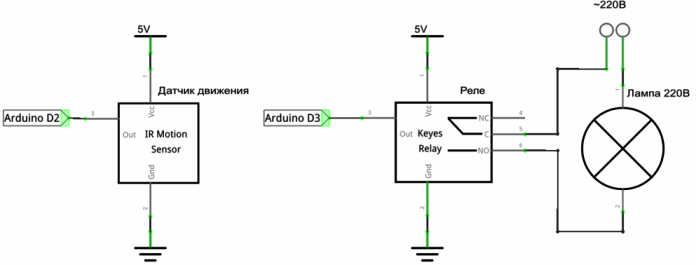
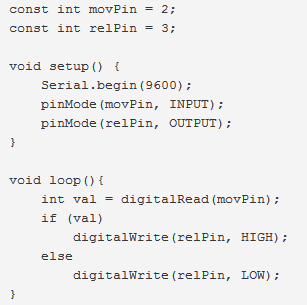
Ultrasonic
The emitter operates at high frequencies - from 20 kHz to 60 kHz. One trouble comes from here - animals, such as dogs, are sensitive to these frequencies, moreover, they are used to scare them away and train them. Such sensors can annoy them and problems arise with this.
The ultrasonic motion sensor operates on the Doppler effect. The emitted wave, reflected from a moving object, is returned and received by the receiver, while the wavelength (frequency) varies slightly. This is detected, and the sensor generates a signal that is used to control the relay or the simistor and switch the load.
The sensor works out well, but if the movements are very slow, it may not work. The advantage is that they are not sensitive to changes in environmental conditions.
Laser or photo sensors
They have an emitter (for example, an IR LED) and a receiver (a photodiode of a similar spectrum). This is a simple sensor, it can be implemented in two versions:
1. The emitter and photodiode are mounted in the passage (controlled area) opposite each other. When you pass through it, you block the radiation and it does not reach the receiver, then the sensor is activated and the relay is turned on. This can be used in alarm systems.
2. The emitter and the photodiode are next to each other, when you are in the sensor coverage, the radiation is reflected from you and hits the photodiode. This is also called an obstacle detector, it is successfully used in robotics.

Microwave
It also consists of a transmitter and a receiver. The first generates a high frequency signal, the second receives them. When you pass near the frequency changes.The receiver is configured in such a way that when the frequency changes, the signal is amplified and transmitted to the executive body, such as a relay, and the load is switched on.
Microwave motion sensors are very sensitive, they allow you to "see" an object even behind a door or behind a glass, but this also causes problems of false triggering when the object is outside the field of intended visibility.
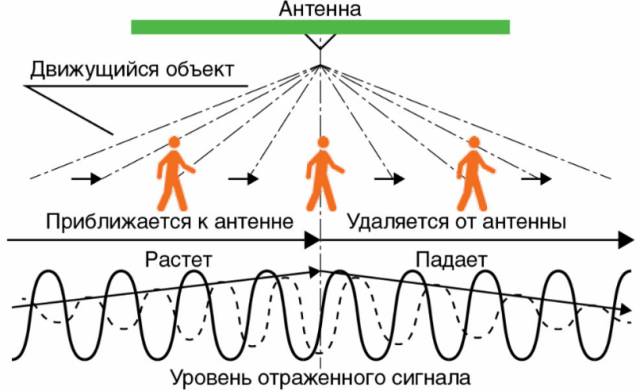
These are quite expensive sensors, but they respond to even the smallest movements.
Capacitive devices work similarly. Such a circuit is shown below.
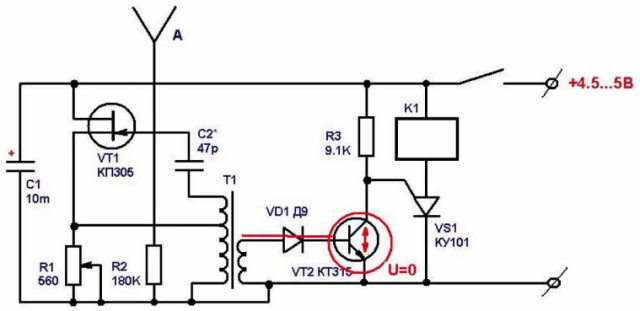
How to connect a motion sensor?
You can come up with countless options and schemes for connecting a motion sensor depending on your needs, sometimes you need the system to work when moving in different places, for example, street lighting on the way from home to the gate and vice versa, in other cases it is necessary to turn on or off the light, etc. .d. We will consider several options.
Typically, a motion sensor has three wires or three terminals for connection:
1. The coming phase.
2. The phase outgoing to power the load.
3. Zero.
If you do not have enough sensor power, use an intermediate relay and 220V magnetic starter with coil. To do this, instead of a light bulb, the coil leads are connected in the schemes below.
Scheme number 1. The lamp turns on only from the motion sensor.
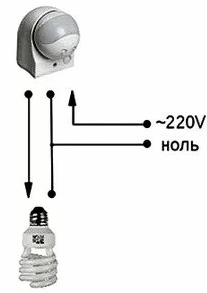
Scheme number 2. The lamp turns on from the motion sensor or from the switch (forced switching on).
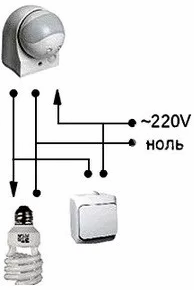
Scheme number 3. The motion sensor is disabled. So it will not work when you do not need it, for example, in the daytime.
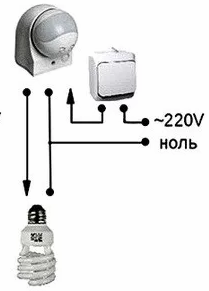
Scheme No. 4 - turning on the lamp from two sensors located in different places.
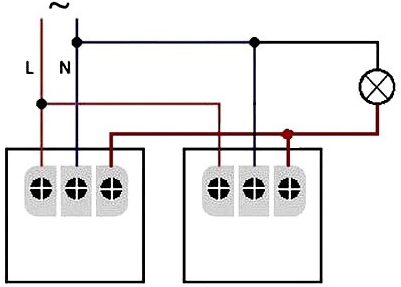
The photo below shows the terminals to which the power wires are connected.
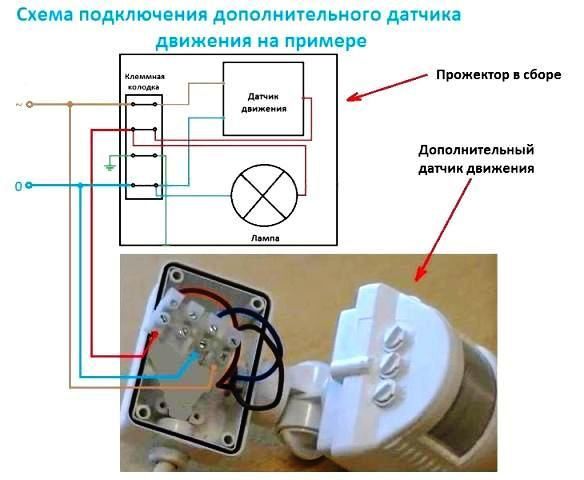
Conclusion
Using motion sensors, no matter how it sounds, is a step to smart home. Firstly, it will help save energy and lamp life. Secondly, this eliminates the need to click the switch every time. To illuminate the street with the right settings, you can make the light turn on when you approach the gate of the house.
If the distance from the gate to the house is 7-10, you can do with one sensor, then you do not have to lay the cable to the second sensor or assemble a circuit with a passage switch.
As already mentioned, the most common are IR sensors, they are enough for simple tasks, if you need more sensitivity or accuracy, take a look at other types of sensors.
See also at i.electricianexp.com
:
